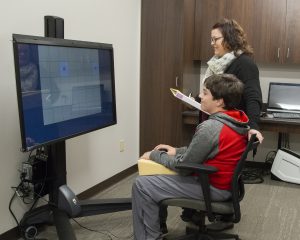What is Vision Therapy?

• eye alignment
• eye tracking and eye teaming
• eye focusing abilities
• eye movements, and/or
• visual processing
Visual-motor skills and endurance are developed through the use of specialized computer and optical devices, including therapeutic lenses, prisms, and filters. During the final stages of therapy, the patient’s newly acquired visual skills are reinforced and made automatic through repetition and by integration with motor and cognitive skills.
Who Benefits from Vision Therapy?
Children and adults with visual challenges, such as:
Learning-related Vision Problems
Vision Therapy can help those individuals who lack the necessary visual skills for effective reading, writing, and learning (i.e., eye movement and focusing skills, convergence, eye-hand activity, visual memory skills, etc.).
Poor Binocular (2-eyed) Coordination
Vision Therapy helps individuals develop normal coordination and teamwork of the two eyes (binocular vision). When the two eyes fail to work together as an effective team, performance in many areas can suffer (reading, sports, depth perception, eye contact, etc.).
Convergence Insufficiency (common near vision disorder)
Recent scientific research — funded by the National Eye Institute and conducted at Mayo Clinic — has proven that in-office Vision Therapy is the best treatment for Convergence Insufficiency.
Amblyopia (lazy eye), Diplopia (double vision), and Strabismus (cross-eyed, wandering eye, eye turns, etc.)
Vision Therapy programs offer much higher cure rates for turned eyes and/or lazy eye when compared to eye surgery, glasses, and/or patching, without therapy. The earlier the patient receives Vision Therapy the better, however, our office successfully treats patients well past 21 years of age.
Recent scientific research has disproven the long held belief that children with lazy eye, or amblyopia, can’t be helped after age 7.
Stress-related Visual Problems – Blurred Vision, Visual Stress from Reading and Computers, Eye Strain Headaches, and/or Vision-induced Stomachaches or Motion Sickness
21st century life demands more from our vision than ever before. Many children and adults constantly use their near vision at school, work and home. Environmental stresses on the visual system (including excessive computer use or close work) can induce blurred vision, eyestrain, headaches, etc.
Visual Rehabilitation for Special Needs – Traumatic Brain Injury (TBI), Stroke, Birth Injury, Brain Damage, Head Injury, Whiplash, Cerebral Palsy, MS, etc.
Vision can be compromised as a result of neurological disorders or trauma to the nervous system. Vision Therapy can effectively treat the visual consequences of brain trauma (including double vision).
Visual Rehabilitation for Special Needs – Developmental Delays, Visual Perceptual Visual-Motor Deficits, Attention Deficit Disorders, Autism Spectrum Disorders
Sports Vision Improvement
Strong visual skills are critical to sports success. Not much happens in sports until your eyes instruct your hands and body as to what to do! We can measure and successfully improve eye-hand coordination, visual reaction time, peripheral vision, eye focusing, eye tracking and teaming, visualization skills, and more.
Vision Therapy can be the answer to many visual problems. Don’t hesitate to contact our office with your questions.